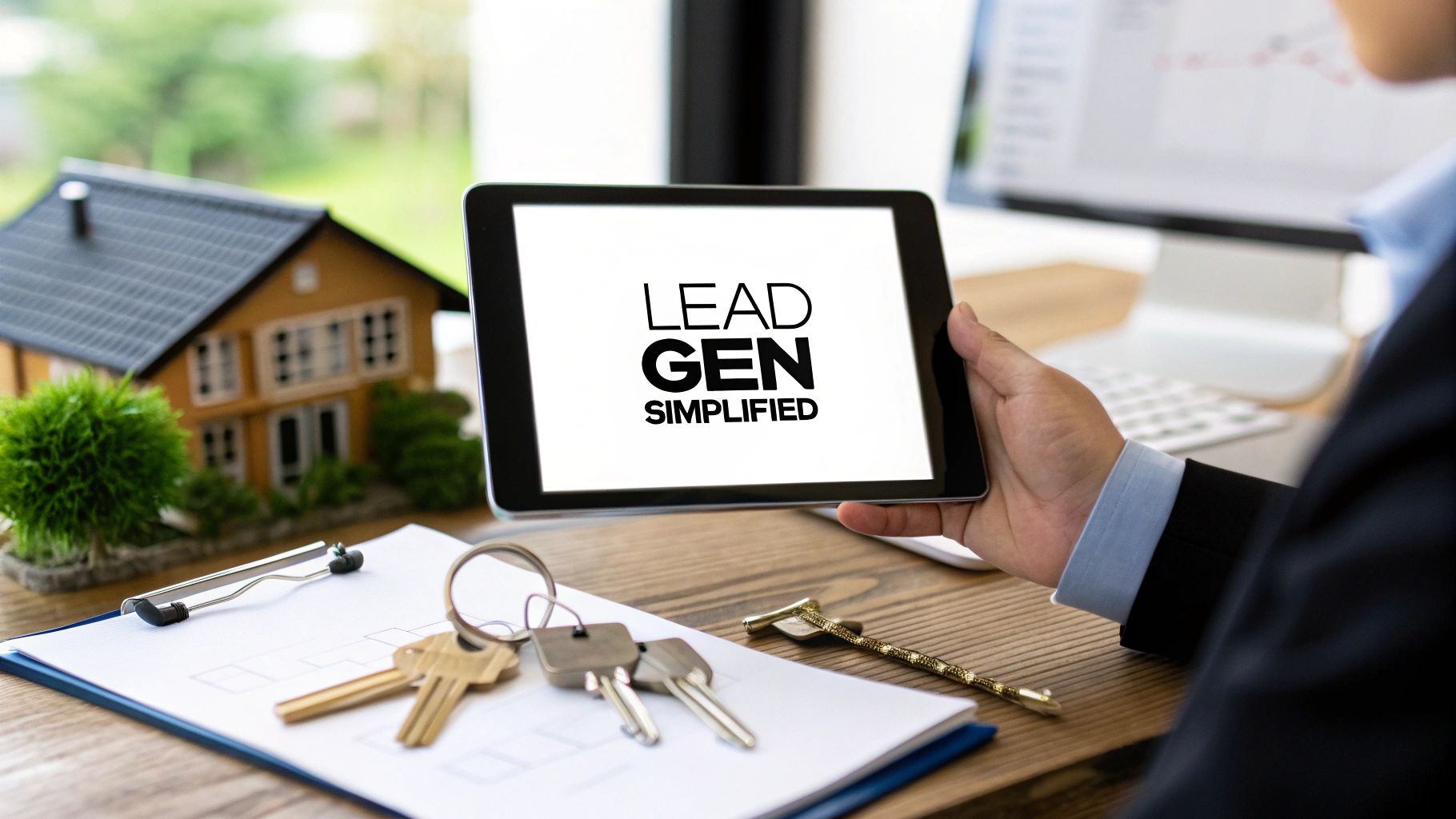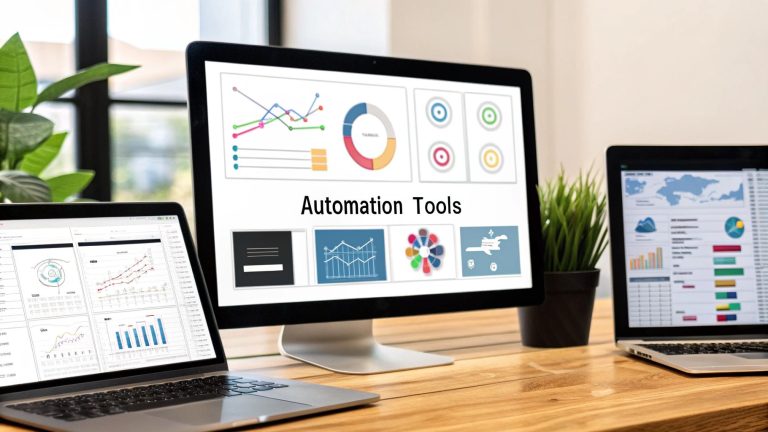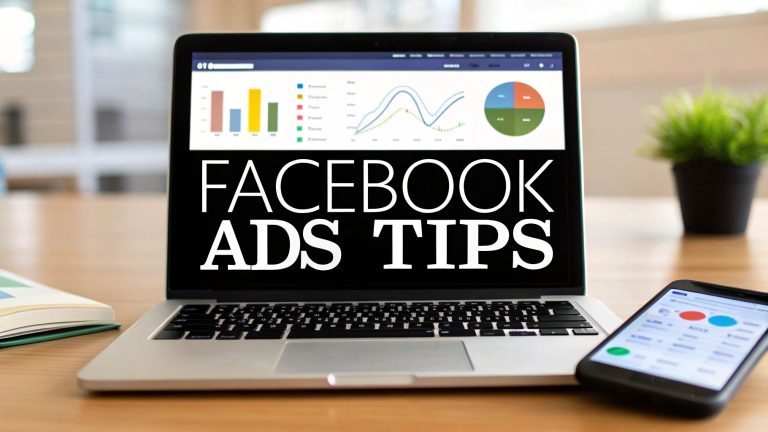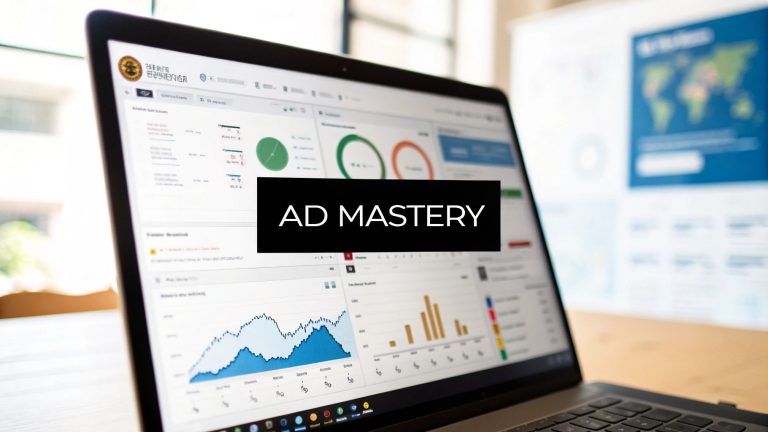Real Estate Agent Lead Generation Simplified
Effective real estate agent lead generation isn't about chasing every shiny object. It's about building a predictable system that brings in quality prospects, day in and day out. This is how you move from scrambling for your next deal to building a sustainable business pipeline.
The secret is blending smart digital strategies with the traditional methods that still work wonders.
Building Your Modern Lead Generation Foundation
Forget about relying on a single source for your business—that's a recipe for a rollercoaster income. A modern foundation for lead generation is all about attracting the right clients through a few core channels that work together. We're aiming for quality over quantity here.
This approach ensures your time and marketing dollars are spent on people who are actually interested and likely to become clients. A resilient strategy mixes different channels to create a stable, predictable flow of leads.
Choosing Your Core Channels
The most successful agents I know don't do everything. They master a few core pillars and build their entire system around them.
Think of it as a balanced portfolio for your business growth. Here are the non-negotiables:
- Targeted Digital Advertising: Platforms like Facebook are goldmines. You can get incredibly specific, targeting people by their location, income, and even life events like getting married or having a baby.
- Hyperlocal SEO: When someone in your town googles "realtor near me," you need to be the name they see. This is all about tuning your website and online presence for local search.
- Genuine Referrals & Networking: This will always be a powerhouse. Strong relationships with past clients and local business owners create a steady stream of warm leads that already trust you.
- Strategic Content: Offering something of real value—like a downloadable guide for first-time homebuyers—positions you as the go-to expert and captures contact info in the process.
To really get ahead, it's worth exploring how new tools can give you an edge. Many top agents are now using AI for real estate marketing to automate and personalize their outreach.
Why You Can't Ignore Social Media
The numbers don't lie. A staggering 92% of U.S. real estate agents use Facebook for their business. Even more telling, nearly half (46%) say social media is where their highest-quality leads come from. Building relationships online isn't just a trend; it's a cornerstone of success today.
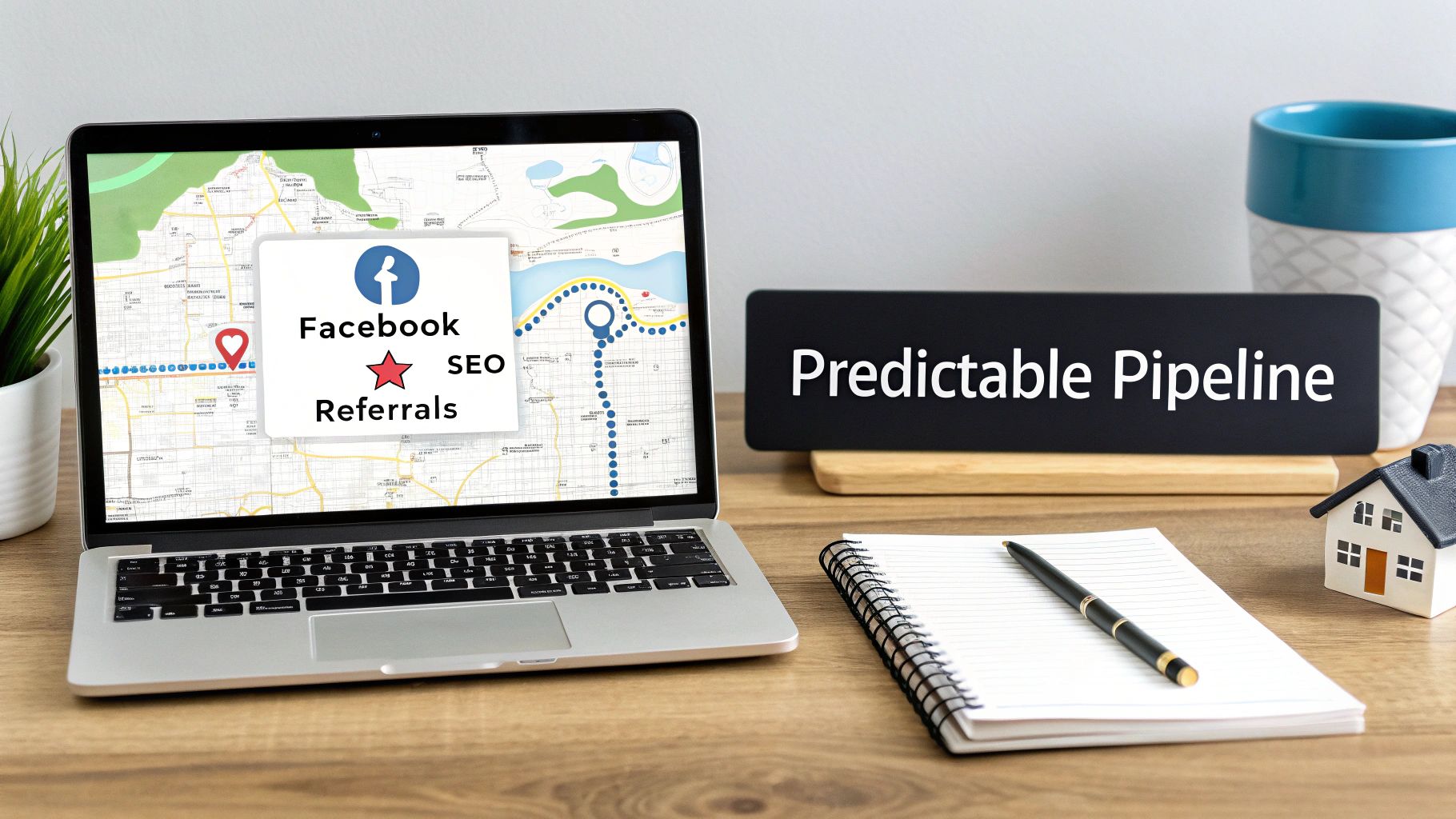
Facebook Lead Ads, for example, are incredibly effective because they make it ridiculously easy for someone to give you their information without ever leaving the app. Less friction means more leads. It's that simple.
To help you decide where to focus your energy, here's a quick breakdown of the most common channels.
Comparing Top Lead Generation Channels for Real Estate Agents
This table gives you a quick glance at the pros and cons of each primary channel, so you can see what might be the best fit for your budget and goals.
| Channel | Average Cost | Effort Level | Typical Lead Quality | Time to See Results |
|---|---|---|---|---|
| Facebook Lead Ads | Low to Medium | Medium | Varies (Top of Funnel) | Fast (Days) |
| Referrals/Networking | Low (Time-based) | High | Excellent | Slow (Months/Years) |
| Open Houses | Low to Medium | High | Good to Excellent | Fast (Immediate) |
| SEO (Organic) | Medium to High | High | Excellent | Slow (6-12+ Months) |
While each channel has its place, a balanced approach is usually best. Digital ads get you leads now, while SEO and referrals build your long-term foundation.
The Role of an Integrated Tech Stack
Running multiple lead channels can get messy fast without the right tech to keep it all organized. Your "tech stack" is the central nervous system of your business. It’s not about having a dozen complicated tools, but a few key ones that talk to each other.
Your tech stack should automate the mundane so you can focus on the meaningful. Its job is to capture, organize, and tee up conversations, not create more admin work.
A tool like LeadSavvy Pro is the perfect example. It acts as the bridge connecting your Facebook Ads directly to your CRM or even a simple Google Sheet. A new lead comes in, it's instantly routed, and you get a notification.
This kind of automation is a game-changer. It eliminates manual data entry, ensures no lead ever falls through the cracks, and lets you follow up in minutes—which is absolutely critical for converting online leads. And while paid ads are a fantastic way to fill your pipeline, don't forget there are other smart ways to find clients. We cover several in our guide on how to get https://leadsavvy.pro/post/free-leads-for-realtors/.
Crafting Facebook Ads That Actually Capture High-Quality Leads
Let's be honest, hitting the "Boost Post" button is easy. But building a real, strategic Facebook Ad campaign that consistently drops qualified leads into your lap? That's a whole different ballgame. To win at real estate agent lead generation, you have to get past the vanity metrics and build ads that work for you 24/7.
The magic of Facebook Ads isn't just about reaching a lot of people; it's about reaching the right people with surgical precision. This is where you stop throwing your marketing budget into the wind and start having meaningful conversations with people who are actually thinking about buying or selling a home.
Pinpointing Your Ideal Client with Precision Targeting
Every great ad campaign starts with knowing exactly who you're talking to. Forget targeting your entire city. Facebook’s Ads Manager gives you the tools to get incredibly specific, which is how you maximize your ad spend and dramatically improve the quality of your leads.
Here are the targeting layers I always recommend agents use:
- Detailed Demographic Targeting: This is so much more than just age and gender. You can target based on income levels, major life events like "Newly Engaged" or "Recently Moved," and even specific job titles. Think about it: you can target renters in a high-income zip code who have also shown an interest in Zillow. Now that's a powerful audience.
- Location-Based Targeting: Don't just type in your city name and call it a day. Use the "drop pin" feature to target specific zip codes or draw a tight radius around a sought-after neighborhood or school district. This is perfect for hyperlocal ads like, "Get a List of All Homes in the Northwood School District."
- Custom and Lookalike Audiences: This is where you really start playing chess. You can upload a CSV of your past clients to create a Custom Audience. Then, you can ask Facebook to build a Lookalike Audience—a brand new group of people who share similar online behaviors and characteristics with your absolute best clients. In my experience, this is the single most effective way to find high-quality seller leads.
An ad shown to a well-defined audience of 1,000 perfect potential clients is infinitely more valuable than a generic ad blasted to 100,000 random people. Precision is everything if you want to see a real ROI.
When you layer these targeting options, you create a hyper-relevant audience that’s far more likely to click. For a deeper dive into audience creation and more advanced strategies, check out our comprehensive guide on generating leads on Facebook.
Designing Ad Offers and Creatives They Can't Resist
Your targeting could be dialed in perfectly, but if your offer is lame or your creative is boring, people will just scroll right past. Your ad has one job: stop the scroll and give someone a compelling reason to give you their contact info. It needs to answer their unspoken question: "What's in it for me?"
The best-performing ads almost always offer something of genuine value in exchange for a name, email, and phone number. Let's look at two real-world examples that consistently crush it for agents I've worked with.
Example 1: The Go-To Offer for Seller Leads
- The Offer: "Free Instant Home Valuation: Find Out What Your [Your City] Home is Really Worth in Today's Market!"
- The Psychology: This plays directly into a homeowner's curiosity and financial interest. Using words like "Instant" and "Free" removes friction, and adding your city name makes it feel personal and local.
- The Visuals: Use a crisp, professional photo of a stunning home in a recognizable local neighborhood. Please, no generic stock photos. A short, simple video of you explaining the current market trends can work even better.
Example 2: The High-Converting Offer for Buyer Leads
- The Offer: "Get the List! See All Homes for Sale in [Neighborhood Name] Under $500k."
- The Psychology: This offer is specific and feels exclusive ("Get the List"). It solves a major pain point for buyers who are sick of endlessly scrolling through Zillow. It creates urgency and delivers an immediate solution.
- The Visuals: A carousel ad showing off 3-4 of the most attractive homes from that list is a fantastic way to go. It gives them a tangible preview of the value you're about to provide.
Remember, the image or video is the first thing they'll see. It has to be high-quality and directly related to your offer. Don't be afraid to test different creatives; sometimes, a simple change in the main image can cut your cost per lead in half.
Automating Your Lead Flow with LeadSavvy Pro
Getting a steady flow of leads from Facebook is a great start, but it’s only half the job. The real make-or-break moment in real estate agent lead generation is speed. Leads go cold in minutes, and if you're stuck manually downloading CSV files from Ads Manager, you're already losing deals. It's a slow, clunky process that kills momentum.
This is where automation gives you a serious edge. When you build a seamless workflow that instantly grabs and routes every new lead, you stop prospects from ever falling through the cracks. It's not just about being more efficient; it's about fundamentally changing your ability to turn online clicks into actual conversations.
Connecting Your Lead Ads to Your Workflow
First things first, you need to build a bridge between Facebook and the tools you live in every day, like your CRM or even just a simple Google Sheet. A platform like LeadSavvy Pro is built for exactly this, acting as the central hub for all your incoming leads.
Instead of compulsively checking Ads Manager all day, the system does the work for you 24/7. The second a prospect fills out your Facebook Lead Form, their info—name, email, phone number—is captured and immediately sent where it needs to go. This simple connection puts an end to manual data entry for good.
You can get your first workflow up and running in less than ten minutes with our step-by-step guide to automate your Facebook lead ads.
This diagram shows the simple but powerful flow from your ad targeting right through to a captured lead.

As you can see, a well-built ad campaign funnels interested people directly into your system. That makes the automation step absolutely critical to capitalizing on that interest.
Configuring Real-Time Notifications
What’s the point of getting a lead if you don't hear about it for hours? The most crucial piece of any automated system is instant notifications. Speed to lead is everything.
You should set up your system to ping your phone with an email or text the second a new lead drops. That alert is your green light to act immediately while the lead is still hot and your ad is fresh in their mind.
A lead that is five minutes old is exponentially more valuable than one that is five hours old. Instant notifications are non-negotiable for serious agents.
This simple alert system flips your follow-up from reactive to proactive. You could be in a meeting, at an open house, or grabbing lunch and still be the first agent to reach out.
The Power of AI and Smart Automation
This isn't just about moving data from point A to point B anymore. Smart tools are now helping agents engage leads faster and more effectively than ever before. Agentic AI, which combines human oversight with automated tasks, has been shown to slash cold response times by an incredible 52%.
For realtors, this means connecting with hot leads almost instantly, which dramatically boosts the odds of conversion. When you pair this speed with your CRM, the automation can handle initial follow-ups, nurture sequences, and personalized messages, saving agents an estimated 20+ hours every single week.
By embracing this technology, you're not just saving time—you're building a real estate business that is more responsive, scalable, and ultimately, more profitable. This kind of automation lets you handle a higher volume of leads with less personal effort, freeing you up to do what you do best: build relationships and close deals.
Mastering Immediate Follow-Up and Nurturing
Getting a prospect to fill out your ad is just the starting line. Real estate agent lead generation isn't about collecting names; it's about converting them. And honestly, the moments right after that click are where most of the money is made—or lost.
Speed isn't just an advantage; it's the whole game. An online lead's interest is red-hot the second they submit their info, but that window closes shockingly fast. This is where you pivot from automation to genuine human connection. Your goal is to go from being just another agent's name in their inbox to becoming their go-to advisor, and it all starts with that first conversation.
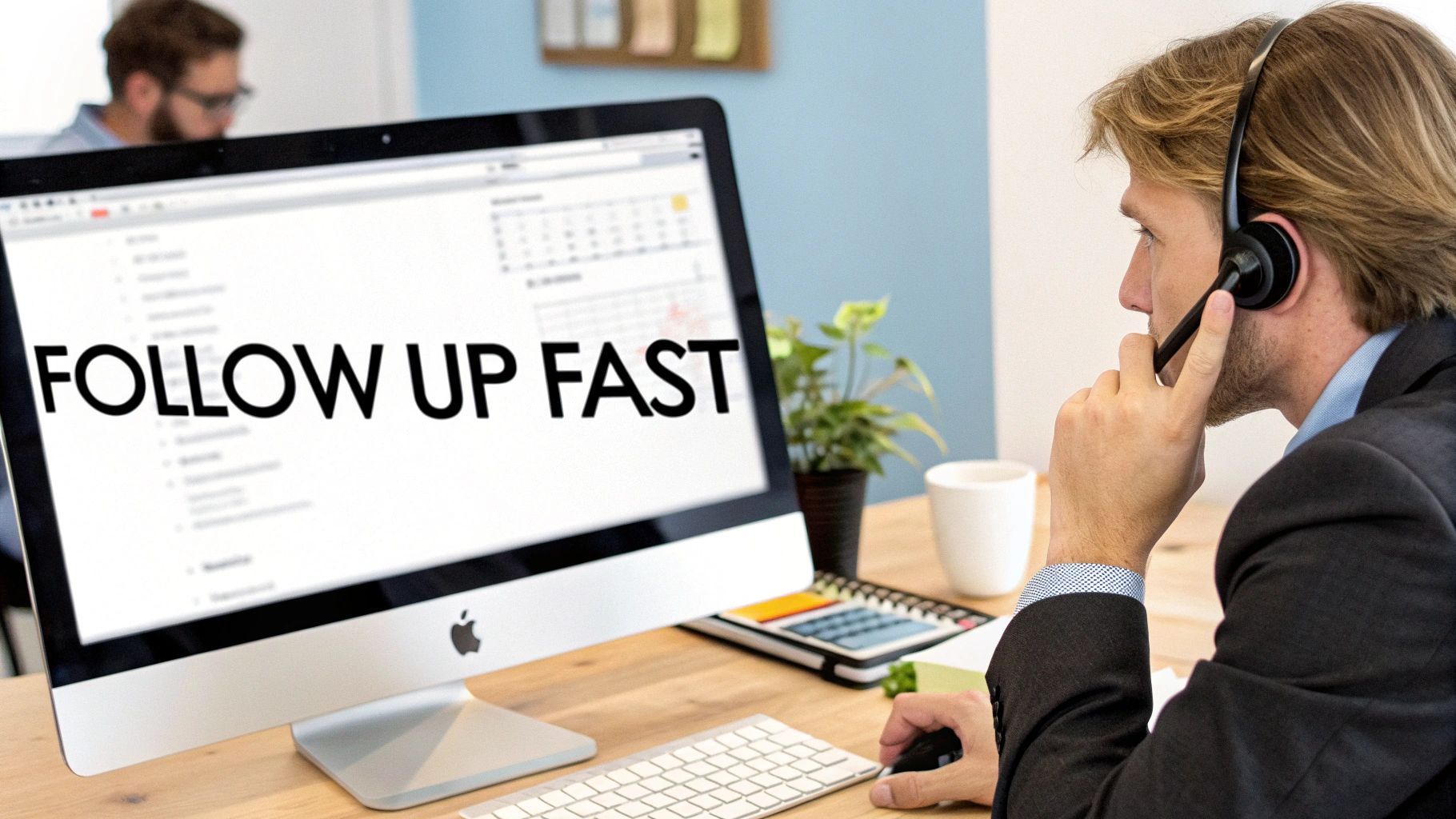
The First Five Minutes
That first contact sets the tone for everything that follows. Forget the hard sell. Your only objective is to build a little rapport, confirm you got their request, and get a feel for their situation. Think of yourself as a helpful expert, not a pushy salesperson.
This initial call or text is your chance to qualify them without it feeling like a high-pressure interrogation. Here’s a simple, field-tested script I’ve used countless times.
Sample First-Contact Phone Script
You: "Hi [Lead's Name], this is [Your Name] with [Your Brokerage]. I just saw your request come through for the list of homes in Northwood under $500k. I’m sending that over to your email right now. Did you have a moment to chat about what you're looking for?"
This opener is intentionally low-pressure. You're immediately giving them the value they asked for and simply opening the door for a conversation, not kicking it down. From here, you can gently pivot into qualifying questions.
Here are a few that work well:
- "Are you just starting your search, or have you been looking for a while?"
- "What are some of the must-have features you're hoping for in a new home?"
- "Have you had a chance to connect with a lender yet to see what you're pre-approved for?"
These questions help you gauge their seriousness and timeline without being invasive. The absolute key here is to listen more than you talk.
Beyond the First Call: A Multi-Touch Nurture Sequence
Let's be real: one phone call is almost never enough. The vast majority of online leads aren't ready to buy today, tomorrow, or even next month. This is where a smart, value-driven nurture sequence becomes your secret weapon for conversion.
The goal is to stay top-of-mind by being consistently helpful, not by spamming them with "Just checking in!" messages that get ignored.
A Simple 30-Day Nurture Plan
This sequence uses a mix of email and text to provide value without being annoying.
| Touchpoint | Channel | Message Focus |
|---|---|---|
| Day 1 | Phone/Text | Initial contact and delivery of requested info (e.g., home list). |
| Day 3 | Send a helpful article: "5 Common Mistakes First-Time Buyers Make." | |
| Day 7 | Text | A simple check-in: "Hi [Name], any of those homes I sent catch your eye? Let me know if you'd like to see any in person this weekend!" |
| Day 14 | Provide a local market update: "Here's what the [Your City] market did last month." | |
| Day 30 | Send a new, relevant list of properties: "Just wanted to share a few new homes that hit the market this week that fit your criteria." |
This structured approach gives you a legitimate reason to reach out every single time, positioning you as a proactive market expert.
The Long Game: Patience Pays Off
It’s so important to understand that lead conversion in real estate is a marathon, not a sprint. I see so many agents get discouraged when a lead doesn’t convert within 90 days, but the data tells a completely different story.
For every 100 prospective homebuyers you generate, only about 5 will likely buy within the first year. But here's the kicker: an additional 5 are likely to purchase within 24 months. This points to a potential 10% conversion rate over two years—a number most agents never hit because they give up way too soon. You can discover more insights about long-term lead conversion on RealGeeks.com.
Your CRM is your gold mine. A lead that says "not right now" is not a "no forever." Consistent, valuable follow-up for 12, 18, or even 24 months is how top producers build massive pipelines.
This reality makes a long-term nurturing system non-negotiable. Automating parts of this with email drips and market updates ensures no one falls through the cracks. Your persistence, backed by genuine value, will pay off when that "someday" buyer is finally ready to move. And because you’ve been the one helping them all along, you’ll be the only agent they think to call.
Tracking Success and Optimizing for Growth
Getting a steady flow of leads is a huge win, but honestly, that’s just the start. The real secret to scaling your real estate business is figuring out what’s working, what’s a complete waste of money, and why. It's time to stop guessing and start making sharp, data-driven decisions that actually grow your bottom line. This is how you build a predictable real estate agent lead generation machine.
Without tracking, you’re flying blind. You could be burning hundreds of dollars on a Facebook ad that feels like a hit but never turns into a single real appointment. On the flip side, a campaign that seems quiet could secretly be your most profitable one. Knowing your numbers is the only way to cut the dead weight and double down on the strategies that deliver a real return.
Key Performance Indicators You Must Track
To get a clear picture of how your campaigns are really doing, you need to laser-focus on a few essential metrics, or KPIs. These aren’t just vanity numbers; they are the vital signs of your marketing. And the best part? The data from your automated system, whether it’s a full-blown CRM or a simple Google Sheet powered by LeadSavvy Pro, makes tracking these a breeze.
-
Cost Per Lead (CPL): The most fundamental metric. It tells you exactly what you’re paying to get one person's name, email, and phone number. Simple as that.
-
Lead-to-Appointment Ratio: This is all about lead quality. It answers the most important question: "Out of all these leads, how many are actually turning into a qualified appointment?"
-
Return on Ad Spend (ROAS): This is the ultimate measure of whether your ads are making you money. For every single dollar you put into advertising, how many dollars in commission are you getting back?
Keep an eye on these numbers every week. You’ll start to see trends, pinpoint your most profitable ad copy and images, and make smart, confident tweaks to your budget.
Measuring your performance isn't about creating more work; it's about making your work more effective. Data tells you where to invest your two most valuable resources: time and money.
By focusing on these core KPIs, you shift from a mindset of just getting "more leads" to getting more profitable leads. This is the exact pivot that separates the agents who are always grinding from the top producers who have predictable systems.
A Practical Example of Optimization
Let's break this down with a real-world scenario. Imagine you're running two different Facebook ad campaigns for seller leads.
-
Campaign A ("Free Home Valuation"): You spend $300 and get 30 leads. Your CPL is $10. From those 30 leads, you manage to book 3 appointments. That gives you a solid Lead-to-Appointment ratio of 10%.
-
Campaign B ("Seller's Guide to Staging"): You also spend $300, but this time you get 60 leads. Your CPL looks amazing at only $5. Here's the catch: from those 60 leads, you only book 1 appointment. Your ratio plummets to a measly 1.7%.
On the surface, Campaign B looks like a home run with its cheap $5 leads. But when you dig in, Campaign A is the clear winner because it’s actually generating appointments—the thing that leads to listings. This insight gives you the confidence to kill Campaign B and funnel that budget straight into Campaign A, maximizing your chances of closing a deal.
Essential KPIs for Real Estate Lead Generation
To really get a handle on your campaign performance, you need a dashboard of key metrics. Think of it as the control panel for your business. Here’s a breakdown of the numbers that matter most, what they mean, and what a good benchmark looks like in the real estate world.
| Metric (KPI) | What It Measures | How to Calculate It | Good Benchmark |
|---|---|---|---|
| Cost Per Lead (CPL) | The direct cost to acquire one new lead. | Total Ad Spend / Total Number of Leads | $10 – $50 (varies by market) |
| Lead-to-Appointment Ratio | The percentage of leads that become qualified appointments. | (Number of Appointments / Total Leads) x 100 | 5% – 15% |
| Appointment-to-Client Ratio | The effectiveness of your sales process after the appointment. | (Number of New Clients / Total Appointments) x 100 | 20% – 40% |
| Return on Ad Spend (ROAS) | The gross revenue generated for every dollar spent on ads. | Total Commission Earned / Total Ad Spend | 3:1 to 5:1 (or higher) |
| Conversion Rate | The overall percentage of leads that become clients. | (Number of New Clients / Total Leads) x 100 | 1% – 3% |
Tracking these metrics isn't just about crunching numbers; it's about understanding the story your data is telling you. A high CPL might be fine if your appointment ratio is amazing, and a low ROAS is a clear signal that something in your funnel is broken.
Using Data to Scale Your Business
Once you have a system for tracking your KPIs, you can start optimizing for serious growth.
When you find a winning campaign—one with a great CPL and an even better appointment ratio—it’s time to pour some gas on the fire. Start by gradually increasing the daily budget on that ad. As you do, keep a close eye on your numbers to make sure the performance holds steady.
This methodical, data-first approach takes the emotion and guesswork out of your marketing. You’re no longer just hoping for results; you're engineering them. This is how you transform your advertising from a business expense into a powerful, revenue-generating investment.
Common Questions Agents Ask
Diving into a new lead generation system, especially when you're putting your own money on the line, always brings up a few questions. That's completely normal. Getting these things ironed out from the start will give you the confidence to really commit to the process and see it through.
Let's tackle some of the most common questions I hear from agents building out their lead gen machine.
How Much Do I Really Need to Spend on Facebook Ads?
When you're just getting your feet wet, a great starting point for a solo agent is somewhere between $10 to $20 per day.
That budget is the sweet spot. It's enough to get you real, meaningful data on what ads and audiences are working, but it won't break the bank while you're in that testing phase. The key here is consistency, not a massive one-time spend. A steady daily budget gives the Facebook algorithm time to learn who to show your ads to. Once you find a winning campaign, that's when you can confidently start scaling up.
What's the Single Biggest Mistake Agents Make with Online Leads?
Easy. Following up too slowly. It's the most common and most expensive mistake you can make.
A lead's interest is white-hot for about five minutes after they hit that "submit" button.
Waiting a few hours—or worse, until the next day—is a deal-killer. By then, they've cooled off, forgotten which ad they even clicked on, or, most likely, they've already talked to another agent who was quicker on the draw.
This is exactly why automation isn't just a "nice-to-have" anymore; it's a must. Getting an instant notification from a tool like LeadSavvy Pro means you can engage while you're still top-of-mind. That speed dramatically increases your chances of turning that click into a real conversation.
Should I Go After Buyer Leads or Seller Leads First?
For agents new to paid ads, I almost always recommend starting with buyer leads. It's the smartest, most efficient way to learn the ropes without taking a huge financial gamble.
Here’s the simple logic behind it:
- Buyer Lead Campaigns: Think "List of Homes Under $500k." These ads typically generate leads at a much lower cost. They help you build momentum, practice your scripts, and get some cash flow coming in faster.
- Seller Lead Campaigns: These are the holy grail for many agents, but they're more expensive to acquire. The potential payday is bigger, but so is the upfront cost to get that lead.
My advice? Master the buyer lead process first. Generate some commission from those deals, and then reinvest your profits and your new expertise into building out killer campaigns to attract those valuable seller leads. It's a much safer way to grow.
Stop letting your best leads go cold. LeadSavvy Pro sends your Facebook leads straight to your CRM or a Google Sheet the second they come in, so you can connect in moments, not hours. Start automating your lead flow for free!

